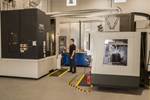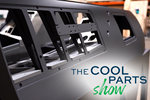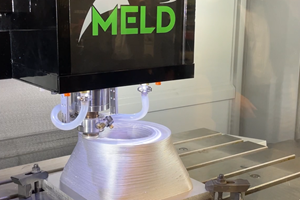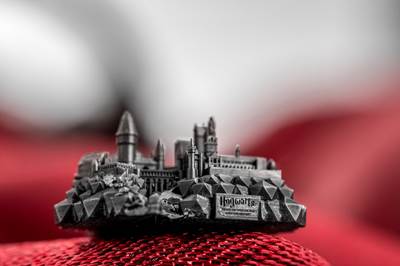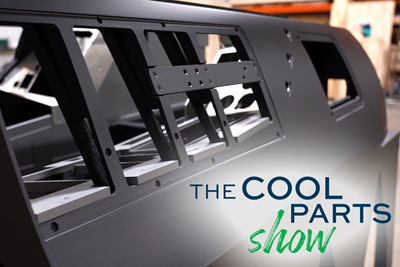Big parts present big manufacturing challenges. Large workpieces are challenging to transport and handle, while large molds or other tooling present similar problems. But making large parts through 3D printing avoids these challenges, and in some cases even avoids the need for a large machine, since a robot might 3D print the large-scale form instead. Julia Hider and I discuss additive manufacturing as a solution for big parts on the AM Radio podcast. Listen above, find it in your podcast app or scroll down for the transcript.
Transcript
Peter Zelinski
All right, we’re back. We were talking about the possibilities that 3D printing brings to micro scale manufacturing and how 3D printing kind of makes that easier, less challenging to make tiny, tiny parts. But there is something similar to say at the other end of the size range. 3D printing brings possibilities to really, really big parts too. Let’s talk about that. Julia, ready to talk about that?
Julia Hider
Yeah. So first of all, what do you mean by really, really big parts? I defined micro. So what’s a really, really big part in additive manufacturing?
Peter Zelinski
Yeah, how big is really big? So let’s say parts from the size of taller than you or me on up to, like, the size of a small room or so.
Julia Hider
Okay, yeah, I’m pretty tall. So that’s pretty tall.
Peter Zelinski
Okay, yeah, we’ll even say taller than Julia. Julia is taller than me.
Julia Hider
I'm like 5'10", or 5'11", for reference.
Peter Zelinski
So yeah, using Julia as a reference, really big parts.
Julia Hider
So for micro 3D printing, we talked about resin based systems. What type of processes are common for large scale additive manufacturing?
Peter Zelinski
So yeah, that’s the right place to start. Because we mentioned how the deposition type processes, you don’t associate them with micro scale work, you wouldn’t get the accuracy you need, obviously, with a really, really big part. In relative terms, the accuracy of each layer is less significant. And so processes that involve depositing material can be scaled up, and oftentimes can be scaled up pretty big. But I think actually, there’s a connection between the micro scale work and the really big work because in both cases, part of the reason why 3D printing is so effective is because 3D printing is production without force. There’s not cutting force to worry about. And in the micro scale work in the force, we’d be worried about breaking a tiny tool. The options that 3D printing brings to really big work, part of it’s because you don’t have to worry about the kind of force that would require you to say, like, build a really big machine. Instead, you can use a robot for deposition. And we’ve seen examples of that in both polymer and metal, really big parts produced by laying on the material. So throwing out an example, last year I had a chance to visit Lincoln Electric Additive Solutions. They make big tools and big production parts by using robots to perform what they call wire arc additive manufacturing. Wire feed metal stock to lay on metal. And mostly it’s been big, big tools. Like, for composites layup, they’ve made, they’re, they’re making, but they’re now getting into big production parts as an alternative to like big foundry parts — big, big parts you might otherwise make through casting.
Julia Hider
Yeah, that’s really interesting because in subtractive manufacturing, when you’re talking about robots, you’re normally talking about using them to load and unload a machine tool, or sometimes you hear about them welding, which is similar to additive manufacturing.
Peter Zelinski
Right? Well, it’s super similar in this case. Like, so yeah, a welding robot might be joining maybe pieces of sheet metal. In this particular additive process, this directed energy deposition process, it’s, it’s basically all welding, like, you could think about it that way. And Lincoln Electric is a company — like they know all about welding. And they’ve parlayed that into additive manufacturing. But yeah, it’s making the part with the robot. It’s just making the whole thing with the robot. And that’s, that’s not something we usually get to see. But, but again, there’s no force involved, and that’s huge. So, like, a couple things. That means the part can be just as big as the robot can reach and get a robot with really long reach. It could make a really big tall part and the cost saving, and the floor space saving, because there’s a lack of force, there’s no, there’s no mold you have to push together, there’s no cutting tool you have to hold against the cutting deflection, there’s nothing like that. So that means you don’t have to build a machine around the part, you don’t have to build a frame around the part that’s bigger than the part is. So among other things, this is a really space efficient way to build big objects.
Julia Hider
So obviously, the parts made using these processes are only as big as the robot will allow. So is there any way to get bigger than that?
Peter Zelinski
So yeah, so get, let me tell you about this, this cool thing I saw. So, um, Oak Ridge National Lab has this kind of neat idea for taking the robot deposition concept even farther. So their system is called Medusa. And it’s three different robots, equally spaced around a turntable, basically like this super huge turntable. And it’s, like, I don’t know, like 10 feet in diameter or so. And the deposition program kind of splits the work among the different robots. And they all work together to build a part. And so it’s welding again. So these beads, these layers of liquid metal, they kind of flow together, even though they’re, they’re deposited from different robots. And so this thing I was saying about how the part can be as big as the robots reach — well, the robots can collaborate, and it could be even bigger than any single robot’s reach. This is an idea that Oak Ridge National Lab, but they’re at their Manufacturing Demonstration Facility, they’re just starting to experiment with this. But yeah, Lincoln Electric’s involved in this too. And they’re seeing how far they can take this. Like, how big could the tool be that you could make with a system like this?
Julia Hider
Yeah, that sounds really cool. So all of the processes that we’ve talked about so far involve robots. Are there any large area additive manufacturing processes that don’t involve robots? Sure, robots are cool. But yeah, we have to talk about something.
Peter Zelinski
Sure. So, so like, like large scale manufacturing, like it happens in boxes, too, like we’re talking about how you don’t have to build the box around the around the part. But it is also pretty cost effective to build a really big box for a large-scale deposition process. So the BAAM is maybe the best known acronym in this area, Cincinnati Incorporated their platform, Big Area Additive Manufacturing, polymer deposition, pellet fed polymer, some users of this system that we know really well, Akron, Ohio, Additive Engineering Solutions. They’re making that same transition I just described with Lincoln Electric, who started out doing tooling and have done mostly tooling, but now they’re seeing some production parts, like the same thing is happening for the really, really huge composite reinforced polymer parts that that AES makes. They founded their business to make big, big, big tools, but they’re making production parts too. And we’ve actually, we’ve actually done two different episodes of The Cool Parts Show on production parts that they’ve been involved in making on their system, gigantic whole sections for an autonomous underwater vehicle, a robot sub and more robots. Oh, yeah, keeps coming back to robots. And, and a flight simulator housing in this this housing that pilots practice and, and it used to be like assembled from hundreds of different pieces. And now they 3D printed and like three big components. It’s a weird idea to be able to just print parts at that scale and not have to have assembly involved in it. But manufacturers, design engineers are kinda, like, figuring out the availability of this option and moving into that space.
Julia Hider
Okay, so we’ve talked about DED, we’ve talked about FDM. What about powder bed fusion processes?
Peter Zelinski
Right? Right. So these are not making big parts of the bigness we were describing, like parts taller than you at a powder bed. I haven’t seen that yet.
Julia Hider
That would that would be a lot of powder.
Peter Zelinski
But these are machines also that are scaling up and the, and the really accomplished users of these machines, for the most part, are pushing for bigger envelope sizes and their engineering challenges. They’re maintaining the consistency and precision of the laser across a bigger build volume, managing the thermal effects across a bigger build volume. That is being accomplished. We’re going there. And there’s this really important reason why that’s so valuable. Sintavia in Florida is a manufacturer. They make engine related aircraft parts — is sort of their niche and their specialty — and they want to go bigger with laser powder bed fusion and the CEO there, Brian Neff, pointed out like the simple fact that a big machine, it lets you do really big parts. So even more assembly consolidation, but the other thing is, it lets you do lots of little parts at the same time if you want to too, and that’s pretty huge. And that’s another example of additive at larger scales, that isn’t quite the same as other manufacturing processes. Like, you could use a really big CNC machine tool to machine lots of parts. But it’s not as straightforward. You’d have to fixture all those little parts — you’d have to do all that setup. It doesn’t look like that in additive a build of, like, 100 tiny parts in the same build versus one big complicated part. It’s the same level of prep time for the one build or the other. It looks kind of the same as far as the use of that machine. And that makes bigger powder bed machines really versatile.
Julia Hider
Yeah, that’s a really interesting point how it doesn’t translate in the same way to subtractive manufacturing as it does in additive manufacturing.
Related Content
10 Important Developments in Additive Manufacturing Seen at Formnext 2022 (Includes Video)
The leading trade show dedicated to the advance of industrial 3D printing returned to the scale and energy not seen since before the pandemic. More ceramics, fewer supports structures and finding opportunities in wavelengths — these are just some of the AM advances notable at the show this year.
Read More3 Points About 3D Printing Large Parts We Can Learn From the Lunar Habitat (Video)
Ingersoll Machine Tools describes the capabilities and promise of large-scale additive manufacturing as seen in the 3D printed sections of the Rosenberg Space Habitat.
Read More3D Printing From Barstock Using Friction Stir Welding (Video)
A look at the Meld Manufacturing metal AM process. The machine tool in this video builds an additively manufactured part by rotating and compressing metal bar.
Read MoreNext-Gen Horse Trailers to Be Built With Robotic 3D Printing
Double D Trailers is currently developing a prototype horse trailer that will be made with large-format additive manufacturing. The technology brings potential benefits for labor, weight and design features to this subset of recreational vehicles.
Read MoreRead Next
10 Ways Additive Manufacturing Reshapes a Production Facility (Forget What You Know About Factories)
Sintavia’s purpose-built facility for powder bed fusion of aircraft components illustrates fundamental ways the plant is different when 3D printing is the operation.
Read MoreZooming in on Micro 3D Printing: AM Radio #10A
This week on AM Radio, Peter Zelinski and Julia Hider discuss additive at the extremes, including micro 3D printing. What are the opportunities and challenges of 3D printing on a microscale?
Read MoreFlight Simulator Made Through Large-Scale 3D Printing: The Cool Parts Show #33
Our biggest cool part so far! Printing this massive structure in one piece saves cost and time for L3Harris.
Read More


